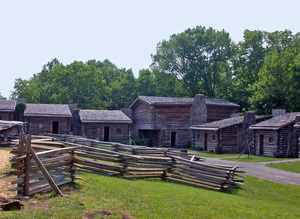On a summer day in 1776, three young girls left the safety of Fort Boonesborough to enjoy a canoe ride on the Kentucky River. A swift current quickly carried their boat to the opposite shore.
Within minutes, the girls were captured by a small group of Native Americans from the Shawnee tribe who hurriedly marched them away through the woods.
The Native Americans were no match for the resourceful daughters of famed wilderness explorers Daniel Boone and Richard Colloway. The young ladies marked a trail for rescuers to follow by dropping torn scraps of their handkerchiefs. The girls stomped their feet to leave prints in the dirt until their captors tore the heels off their shoes.
Two days later, a band of men from Fort Boonesborough overtook the group and rescued the girls. Accounts of the adventure soon reached newspapers back East. The stories heightened Daniel Boone’s reputation as a wilderness scout.
Other fascinating stories can be learned by visiting Fort Boonesborough State Park, located near the town of Richmond in southeastern Kentucky.
Tours of the recreated full-scale fort begin with an exciting new film that introduces visitors to Daniel Boone, considered to be the person most responsible for the exploration and settlement of Kentucky.
Fort Boonesborough protected many of the 200,000 pioneers who traveled the Wilderness Road to the Western frontier. Viewed as intruders by the local Native Americans, the whites of Boonesborough were the major targets of attacks.
Few people know that Boone was tried for treason shortly before one major attack. The incident started when Boone led a group of men to the Lower Blue Licks area to gather salt. They were captured by the Shawnee and taken to Michigan. Chief Blackfish enjoyed Boone’s company so much that he adopted him and changed his name to Big Turtle.
Six months later Boone escaped. When he reached Boonesborough, the settlers were suspicious since his head was plucked bald and he had adopted other Shawnee customs.
They thought Boone’s arrival was the forerunner of an attack, so they put him on trial for treason, but he was acquitted.
Kentucky’s first chartered town had a sort lifespan. Thirty-five years after its founding, Booneborough’s population had dropped to just 68. The historic settlement was destined to become one the West’s first ghost towns.
In 1963, the Kentucky Department of Parks received 57 acres to establish Fort Boonesborough State Park. An archaeological dig located the physical remains of the fort and village.
Visitors can tour working cabins with period furnishings, a blacksmith shop, herb garden, and sheep pen. Costumed interpreters use 18th century antiques to dip candles, weave cloth, make lye soap, and create corn-husk dolls.
The fort’s gift shop offers items made at the fort and other locations in the Commonwealth.
Facilities at the park include a 167-site campground, miniature golf course, boat ramp, swimming pool, and picnic shelters. A self-guided interpretative trail highlights native plants, animals, prehistoric and geological sites.
A reenactment of the Siege of Boonesborough is held annually in September.
Fort Boonesborough State Park is located at 4375 Boonesboro Road, Richmond, Kentucky; (859) 527-3131; www.fortboonesboroughlivinghistory.org.







